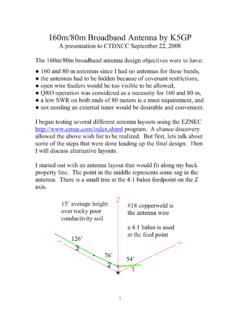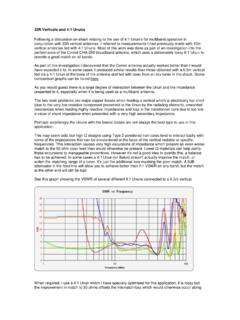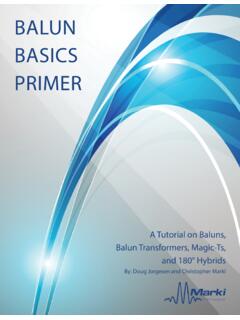Transcription of A 9:1 Balun For Your End Fed Antenna - Mobileers
1 1 A 9:1 Balun For your End Fed Antenna End-Fed antennas do have their place in radio and other communications work. Like everything else, antennas come in many forms and flavors. It's up to the designer to select the best design for the job at hand and to utilize that design in the most efficient way. * * * A Bad Rap? * * * - End-Fed antennas are NOT balanced systems; but neither are verticals, ground planes, discones, windoms, zepps, Marconis, half-slopers, et al. Additionally, the low-impedance Antenna port of your transmitter/receiver is not balanced. - End-Fed antennas are noise magnets. Really? That's because most hams and SWL-ers don't bother to interface them properly. - End-Fed antennas have wild impedance swings. So do all antennas, but not at the design frequency - there, at the design frequency, the terminal impedance is quite predictable.
2 To make the best use of an End-Fed Antenna , it should be fed with a transformer. Here are some photos of one of my 9:1 baluns. However, when using it with an End-Fed Antenna it is wired as a (so-called) "unun" transformer (unbalanced to unbalanced). The raw End-Fed Antenna will go through impedance swings as high as 5K Ohms, or more, at even multiples of its 1/4 wavelength design frequency. At every odd multiple it will be at a more civil impedance of between 36 and 90 Ohms. Using the transformer, the magnitude of the impedance swings is greatly reduced. This is due, in part, to the ratio balancing of the transformer's turns (windings), and to a few complex reactance and other physics attributes that I won't try to cover here. Additionally, the unun will eliminate (virtually) all "common mode" currents on the feedline.
3 This is important for eliminating the pickup of local electrical noise from homes and power distribution lines. The coax, being connected to ground through a DC path will eliminate all but the differential currents .. pretty cool, huh? Finally, since the Antenna is connected directly to Earth ground through the secondary of the transformer, static buildup cannot occur - the Antenna is a dead (DC) short to ground. This is important to sensitive, solid state radios. The 9:1 transformer provides: 1. a much flatter broadband impedance response, 2. a static elctricity-free Antenna system (no buildup), 3. common mode noise immunity (if space wound as shown). 2 3 An Important Note on this Design I selected the separate (spaced, opposite or complementary) winding format over bifiler or twisted-pair winding in order to minimize the coupling effects of stray capacitance between the primary and secondary windings.
4 This symmetry is important to the quality of common mode noise rejection, which is one of the Balun 's attributes - and should be exploited as such. Construction of the 9:1 Balun /unun: I used an old plastic box and a type 75 toroid core. My windings, in this case, are for transmitting, using No. 10 and No. 14 solid copper wire. For SWL-ing a smaller core can be used along with No. 18 or smaller wire. The turns ratio is 3:1 for a transformation of 9:1. The impedance is the square of the turns ratio (Z=T^2). The Antenna terminals are brass speaker terminals and the low impedance side is a standard SO-239. The grounds of the two windings have been isolated but, can be strapped together by the screw 4 contacts (shown in the top photo). The entire assembly was potted with marine fiberglass. Note that I also added a hanger strap for convenience.
5 Testing the 9:1 Balun /unun: Properly designed and constructed toroid transformers are not lossey!!! On the test bench with a 52 Ohm source and a 450 Ohm load the transformer shows a loss of no more than dB with about dB being average, and the low reading of dB. Installation of the 9:1 Balun /unun: The End-Fed is connected to one terminal of the " high " winding and the other terminal is connected to a good "EARTH" ground. One or more copper rods or pipes driven, at least, 4 feet into the earth near the dwelling entry point (2 or 3, is better, being spaced about 4 feet apart). The coax is connected to the SO-239 and fed to your radio. The best place for the Balun for receive-only antennas, is mounting it directly to the primary ground rod and keeping the ground conductors as short as possible. Use a heavy copper wire (not steel or aluminum) or, better yet, low inductance conductors which have an aspect ratio that is other than "round.
6 " The higher the aspect ratio, the better, like flat copper braid or copper sheet metal strap. This, in effect, will give you an inverted "L" Antenna (of sorts), depending on the length of the vertical element. For transmitting, it's best to place the transformer at the actual feed point, up, and away, from possible contact by humans and pets. Of course, extra care must be taken to properly ground the Balun by running the ground conductor down the tree, house, etc. If your Antenna is attached to your tower and ground-BONDED to the household grounding system, as mine is, then you are home free .. just be sure your tower itself is properly grounded .. you'd be crazy if it wasn't suitably grounded the day you put it up!!! A word about grounds. We are talking about RF (signal) ground on this page. These are the grounds that provide the Antenna counterpoise (true ground plane), and afford static bleed to NOT allow lightning's near field (DC component) induction, or just general DC static electricity buildup on he wire, to pass along to your radio.
7 A Balun will not stop the RF component of near-field strikes, although the inductive component of the windings and ferrite will lessen its amplitude. These grounds ARE NOT about electrical service safety. Smart people tie their radio grounds to a common point "service ground" ("BONDING") with heavy gage wire, I do - and this is fine if ALL the other ground measures discussed here have been met. Simply put: electrical service ground is NOT a substitute for a good RF Earth ground, which is required for a good Antenna system. In fact, your service ground will probably be a very bad RF ground and a good source of (household / neighborhood) noise, if not outright dangerous to you and your equipment. Remember, the "neutral" wire in your circuit breaker box travels outside of your home and all around the neighborhood.
8 It's a noise magnet and (going from pole-to-pole) a potential 5 lightning rod!!! Best to consult with a licensed electrician about "bonding" the entire household, IE: electrical service, cable service, telephone lines, and RF grounds. Technically speaking, that addition of outside antennas may modify or invalidate you home's fire insurance coverage. If in doubt, contact your insurance agent. Also, consult with a licensed electrician to be sure you conform to all NEC and local electrical codes for the proper BONDING of ALL service grounds, and ground systems, within and about your home. RF Grounding With a Balun Feed Transformer coupling and properly grounding your end-fed Antenna will offer you four benefits: (1) Greater signal levels across a larger bandwidth (impedance smoothing), (2) Less electrical noise pickup from local sources (common mode rejection), (3) Greater protection to your equipment (constant static bleed and near-strike (DC only) shunting).
9 Shown here are 4 possible ways to connect your transformer ( Balun wired as an unun) to the Antenna and the radio. (Note that the first example uses a coax connector at the transformer and the subsequent figures show the coax as being hard wired - both are acceptable and are options for your particular requirements.) The sketches are pretty much self explanatory. Technically, they are shown in the order of functional preference. If you have trouble reading these sketches, you may "right click" them to your clipboard and paste them to a .jpg viewer. Please give full credit if reused elsewhere. Here is a graphical illustration of a typical installation. The details will be different, but the principles are the same. The primary point is to mount the xfmr as close to the system ground as possible. Mounting it directly to the first ground rod is text book-ideal.
10 An alternate would be to eliminate the vertical component of the Antenna and mount the xfmr to the insulator above it and run a heavy ground up to it. This will depend on how much the vertical wire is exposed to near-field electrical noise from your home. Here is an example of good RF "ground farm" practice. As opposed to many socio-religious beliefs, in this case, more is better! There will be a point of diminishing returns, but generally speaking, one ground rod is not going to be optimal. Experimental and empirical testing is the only way to determine what will be best for you. You may get a relative ground conductivity test as shown below. Most electrical service entry points are grounded to the fresh water (cold water) feed pipe. Homes with plastic well pipes will have some other code-complient grounding system.



